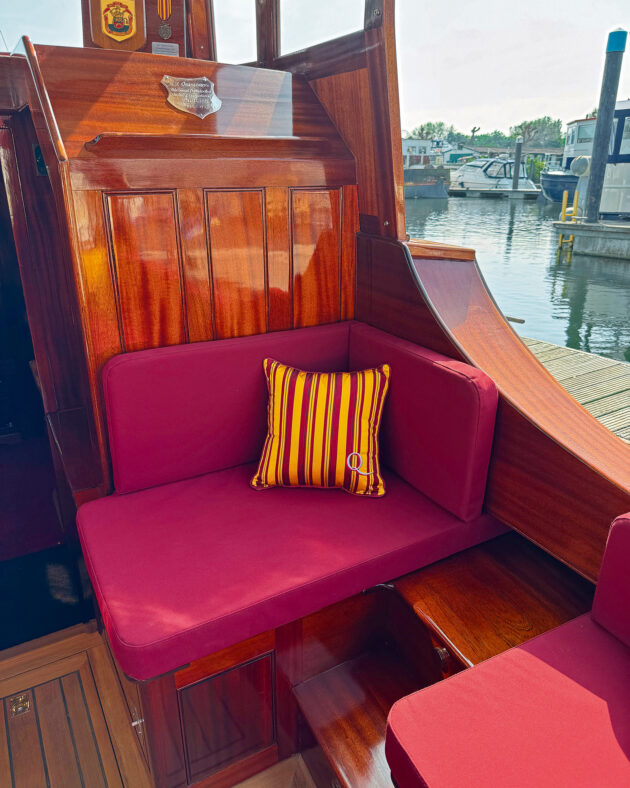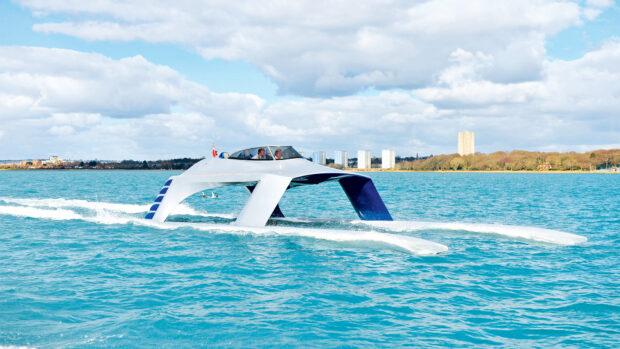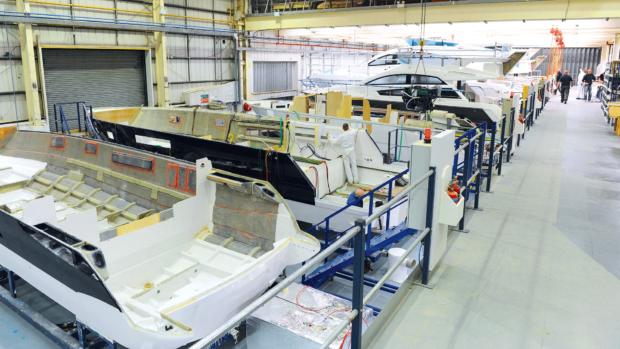Phil Christodolou never planned to own a classic boat but a chance meeting with a neighbouring berth-holder led to him buying and restoring one of Dunkirk’s best known Little Ships
Growing up in West London as the child of a Greek Cypriot father, I’d never have imagined that one day I would own one of the most famous Dunkirk Little Ships ever built. I wasn’t even into history. In fact, I wasn’t into any kind of schoolwork, preferring to spend time hanging out with my pals and devising ways to make a few quid by cleaning cars and selling rock band T-shirts.
I’ve always been fascinated by the sea, though, spurred on by regular trips back to Cyprus and occasional boat outings with family and friends. We might have been living in London but I still had the Mediterranean flowing through my veins.
Perhaps that explains why I trained as a commercial diver, often involving intense periods of salvage work for months at a time. Before long, I had made enough money to buy a little Sea Ray bow rider with my best friend and his family, which we kept in Spain. We would waterski directly off the beach, living the kind of life I never thought I’d have.
Over the years, I dipped in and out of boating, often sharing boats with friends. That culminated in sharing holidays on a 40ft Astondoa based in Menorca. They were fun times but the boats themselves were simply a means to an end rather than a lifelong passion. That all changed in 2021.

Work begins at C&M Traditional Boat Repairs
I had recently come out of a long-term relationship and was looking for a flat in town. I couldn’t get over how expensive even a modest flat was so when my business partner Jon suggested I take a look at a 72ft wide-beam liveaboard barge based in Thames and Kennet Marina, which friends of his were selling, I reluctantly agreed.
I was determined not to buy it and even rehearsed how to say no without offending them, but when I saw it I was bowled over by how modern and spacious it looked. To cut a long story short they made me an offer I couldn’t refuse and I’ve lived on it ever since.

Quisisana being towed into Dover in 1940 after recovering troops from the beaches of Dunkirk. Photo: Getty
Twist of fate
However, it was only when I moved the barge to Penton Hook Marina in Chertsey that things took an unexpected turn. One of my new neighbours was a classic boat enthusiast with close ties to the Association of Dunkirk Little Ships (ADLS). We hit it off straight away and the more I learned about the club and the heroic actions of the 805 small boats which helped rescue the trapped British Expeditionary Force from the beaches of Dunkirk in 1940, the more I found myself wanting to be a part of it.
I’ve always loved the idea of owning a classic wooden boat but could never really justify spending the money purely for my own gratification. Now I had the perfect excuse to throw myself into a restoration project, partly for my own enjoyment but also to help preserve an important piece of history.

All the original rotten planking had to be replaced
And once my mind is set, there’s no stopping me! I looked at two or three Dunkirk Little Ships in various states of disrepair. I drove all the way to Plymouth in thick fog to look at one, only to find that I could put my hand right through the rotten wood of the hull. None of them seemed quite right.
A few weeks later I got a call from Ian Gilbert, the honorary vice admiral of the ADLS. He had been approached by the executor of an estate that included a Dunkirk Little Ship called Quisisana. She had belonged to the executor’s late brother Martin Lowe, who had owned her for years, using her regularly up until 2010 when she was lifted ashore for a ground-up restoration that he started but never managed to complete. Now his brother wanted to ensure she ended up with someone who could finish the job and honour Martin’s wishes.
Article continues below…

Saving Breda: How I brought this 1920 Dunkirk Little Ship back to her best

Cockwells boat yard owner reveals his Dunkirk Little Ship restoration
The boat in question was a 30ft Thornycroft built in 1927. She wasn’t particularly unique, being one of the first production built boats, but her Dunkirk pedigree was exceptional. Her twin engines and small size meant she was ideal for picking up soldiers from the beaches and ferrying them to larger ships offshore. There’s a famous photograph of her returning to Dover, decks laden with troops from the Coldstream Guards, who were last to leave after clearing the beaches.
And her exploits were featured in the July 1940 issue of Motor Boat & Yachting too. Even her name struck a chord, being based on the Italian phrase ‘qui si sana’, which translates as ‘where you are healed’.

The wheelhouse was added in the 1950s
I went to see her in Lowestoft and knew immediately she was the one. It took some imagination as she had been stripped back to the bare hull inside and out but at least I could see what I was getting into. There were no hidden nasties waiting to trip me up and the work that had been done to the keel, stem, sternpost and bottom planks was all to a high standard.
I made an offer of £5,000 to cover the boat and any remaining storage fees, which the executors of the will were only too happy to accept.
To be honest, it wasn’t about the money for any of us. We all knew the cost of restoring it would dwarf whatever I paid for it. The important thing was to finish the job, do justice to the previous owner’s vision and preserve this historic vessel for future generations.

New oak deck beams were needed to brace the hull and support the new deck
Partners in grime
Now I needed to find someone to help with the restoration. The ADLS suggested Malcolm Jones from C&M Traditional Boat Repairs based in Egham. He had already restored a sister ship to Quisisana called Nydia so knew exactly what was needed. We hit it off instantly and I could see he was just as excited as I was. He confirmed that the previous owner’s work was beautifully done but liked the fact that being an empty shell meant we had a blank canvas to work on.
This was important to me too as I wanted a boat that stayed true to its origins but was still a practical cruising craft for fun days out on the water with friends and family. The ultimate goal was to take part in the 85th anniversary commemorations by joining the ADLS fleet of boats crossing to Dunkirk in 2025 and for that it needed to be seaworthy, reliable and equipped with all the latest safety and navigation equipment.
I explained my thoughts to Malcolm and between us we began to draw up plans for what was needed. We soon fell into a regular rhythm of Saturday morning chats that often extended well into the afternoon as we got deeper and deeper into the project.

The wheelhouse was completely rebuilt in African mahogany
I had a ballpark figure of around £150,000 in my head but it soon became clear that neither of us were prepared to skimp on the details just to stay within budget. It didn’t just have to look right, it needed to feel right too.
As I said to Malcolm at the time, “You don’t buy your granny Primark underwear for Christmas!”
My Alistage office became a shrine to Quisisana with my staff producing countless drawings along with photographs pinned to the walls as we bounced ideas around. It rapidly turned into a seven-day-a-week job; we worked on it Monday to Friday, talked about it on Saturday and dreamt about it on Sunday.

It took 12 coats of two-pack varnish to achieve this lustrous finish on the mahogany
Royal connection
The first task was to finish off the hull’s carvel planking, using larch wood harvested from the Sandringham estate. These all had to be bent into place round the oak ribs and secured with copper clench nails and roves just like it would have been in the 1920s.
The gaps between the planks were then plugged with traditional caulking materials to make it watertight before moving on to the teak decks and mahogany superstructure.
At some point in the 1950s a wheelhouse had been added amidships and we decided to replicate this to provide some shelter to the helm and cockpit seating area. African plantation grown mahogany is a different colour to natural Brazilian hardwood so we had to stain it before applying 12 coats of two-pack Skipper’s varnish and a final coat of Jotun Ravilakk.

Marine ply bulkheads and decks were later sheathed in mahogany and teak
The decks were equally involved, requiring new laminated oak deck beams to be made up with decorative softwood cladding on the underside for decorative purposes and fibreglass sheathed marine ply on top to support the final layer of teak cladding. All of this work on the deck required me to dig deep into my reserves and ‘throw the cat another canary’.
However, it was the engineering and fit-out that swallowed most of my time and money, but it was also the part I loved most. I wanted Quisisana to look true to her era and origins but I also needed her to function as reliably and comfortably as a modern boat with all the mod cons I had become accustomed to. That meant either sourcing date-appropriate fittings or hiding stuff away where it wasn’t on show.
For propulsion, we opted for a pair of compact 38hp Beta Marine naturally aspirated diesel engines. She doesn’t need a lot of power but this gives her the manoeuvrability she needs on the river as well as the reliability to cross the Channel. To ensure she had sufficient range for longer trips we designed four custom-built stainless fuel tanks totalling 220 litres of fuel per engine.

The larch carvel planking was sourced from the Sandringham estate and held in place with traditional copper clench nails and roves
I went equally big on battery and inverter capacity to ensure I could have an all-electric galley that can operate for days without access to shorepower. Needless to say all the wiring, including the switchboard is hidden away behind mahogany panels.
Chips with everything
It’s the same story in the galley where a modern induction hob, fridge and sink are all concealed by mahogany covers. Malcolm even made a bespoke mahogany roller shutter to hide my air fryer – no boat is complete without a means of cooking chips!

A state of the art galley is hidden under mahogany covers, including a hob, sink, fridge and air fryer!
The helm is every bit as clever, featuring traditional chrome gauges and organ-stop switches for the main engine controls but also a state of the art Garmin plotter tucked behind another pull-out mahogany panel. It’s also the one area I’ve been allowed to introduce another type of wood – Malcolm insisted on only using oak, larch, mahogany and teak but he made an exception for the two balls of Cypriot olive wood mounted on top of the traditional Morse-style throttle levers.
The helmseat was another one of Malcolm’s inspired ideas. I wanted the ability to sit or stand while helming but finding a flip-up seat that looked the part proved impossible until Malcolm spotted a 1920s theatre seat for sale on eBay. By replacing the base and backrest with wider, made to measure leather-clad supports and respraying the cast-iron mounts and mechanism with marine paint, he created a folding bench that fits like a glove and is perfectly in keeping with the era.

St James’ red leather seats and carpet invoke the feeling of a 1930s gentlemen’s club
Talking of leather, I wanted her to have the look and feel of a 1930s gentlemen’s club so I chose a colour called St James’ red for the fabric cockpit cushions and matching leather seats for the helm and saloon benches. To give it a bit of extra pop, I then commissioned a special red and gold striped silk fabric for the scatter cushions to match the ribbon of the Dunkirk medal awarded to veterans of Operation Dynamo. It was a bit of an extravagance but I am so proud of her history that she deserves special treatment.
The companionway leading down to the saloon proved the ideal spot to create a small bar area with another discreet fridge and a locker for all the Silwy glassware with magnets in the bases to hold them in place on passage.

The helm chair was custom built using the folding frame of an old 1920s theatre seat
Gentleman’s relish
As for the saloon itself, Malcolm and I really went to town on the gentlemen’s club theme. The two main leather banquettes both convert to generous single berths for guests, every inch of the topsides, superstructure and bulkheads are sheathed in varnished mahogany, the deckhead is traditional white painted tongue and groove panelling and the floor is covered in deep pile St James’ red carpet.
It took us a while to figure out a suitable solution for blocking out light from the chromed portholes and eye-level windows as neither of us wanted to fit blinds or curtains but eventually we settled on custom-made leather covers which simply slot over or into the frames when needed.

Silk cushions match the ribbon of the Dunkirk medal
The heads required more clever thinking, with Malcolm crafting a pair of beautifully curved double doors to ensure it wouldn’t impede access to the saloon. The sink is a proper ceramic Burlington affair with traditional style taps and while the toilet is a modern electric flushing one, the mahogany seat and toggle-style flush switch (with a Monty Python style pointing finger etched into the panel showing which way to push it) ensures it all looks authentic.
Last but by no means least is the master cabin in the bow, accessed via a pair of linked sliding doors that open as one whichever side you pull. With hanging lockers either side for my clothes, cubby holes to hide all the electric sockets and plenty of light streaming in through portholes, eye-level windows and frosted glass panels in the doors, it’s a bright but cosy retreat for me to hide away in during the day or night.

Olive throttles are a nod to Phil’s heritage
Tears of joy
The refit has taken us two and a half years to complete and the process has been a real journey for both of us but it has always been a pleasure rather than a chore. Like every project, it has had its ups and downs but I’ve enjoyed every minute of it and the end result is the product of our friendship.
When the day finally came to bring Quisisana back from Malcolm’s yard in Harleyford to Penton Hook last August, it felt strange being on my own. I rang Malcolm just to let him know we had arrived safely and for the first time he went quiet on me. He finally admitted that he was missing having Quisisana around. I’m normally the one blubbing but this time we were both in tears.

Classic exterior lines hide a surprisingly modern and well equipped interior
Since then I’ve taken her to the Classic Boat Festival at St Katharine Docks in London, where she won an award, and enjoyed several wonderful outings along the river for lunch at the Waterside Inn at Bray, tea at Cliveden House and dinner in Windsor and Marlow. She’s always made welcome wherever we go and being quite compact they’ll always try to make space for her.
But perhaps my proudest moment was welcoming a delegation of the Coldstream Guards on board. She even has her own serving liaison officer from the regiment.

Phil (right) was honoured to welcome a delegation from the Coldstream Guards
No regrets
In total she’s cost me over £250,000 but I don’t regret a penny of it. The truth is she gives as much to me as I gave to her. I miss having a family and really struggled through Covid so having a project to sink myself into was exactly what I needed.
I would happily do it all over again, there are plenty more Dunkirk Little Ships that need saving, but for the moment I’m too busy basking in the pleasure of owning such a fabulous piece of history. You don’t get that from a brand new boat, however much you spend.
My focus now is this year’s return to Dunkirk when Quisisana can prove her credentials once again. That will be the icing on the cake.
 If you enjoyed this….
If you enjoyed this….
Motor Boat & Yachting is the world’s leading magazine for Motoryacht enthusiasts. Every month we have inspirational adventures and practical features to help you realise your sailing dreams, as well as tests and news of all the latest motorboats.
Plus you’ll get our quarterly Custom Yachting supplement where we share the last on offer in the superyacht world and at the luxury end of the market.
Build your knowledge with a subscription delivered to your door. See our latest offers and save at least 30% off the cover price.



 If you enjoyed this….
If you enjoyed this….





